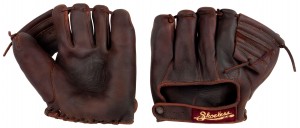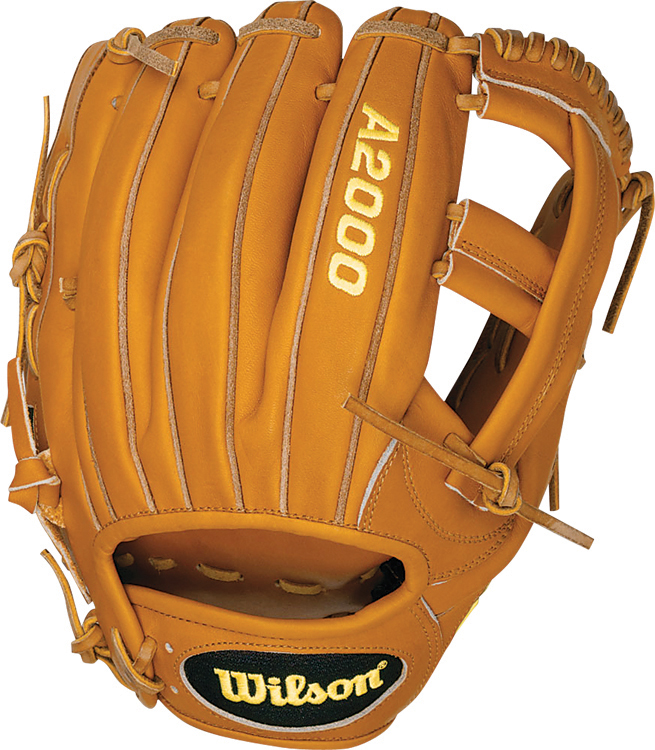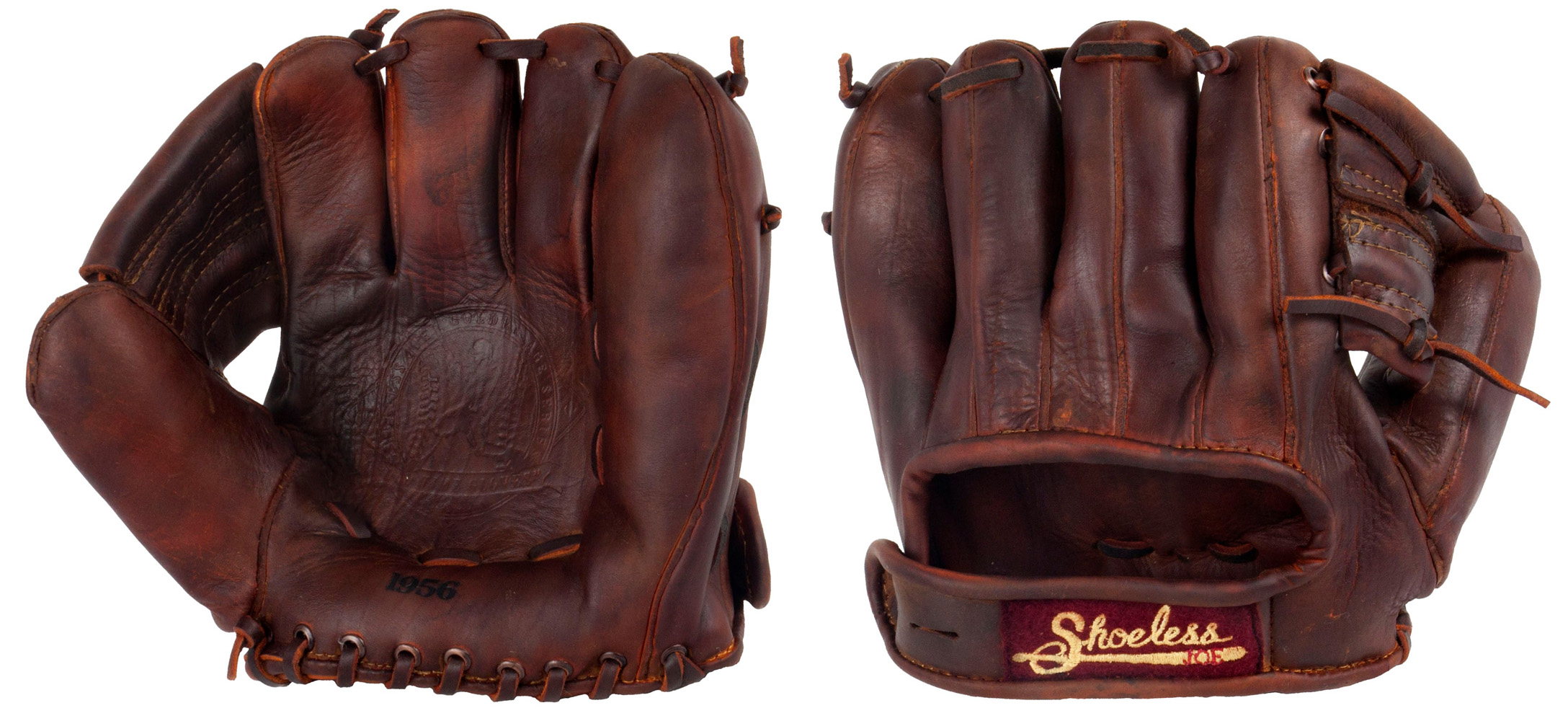Recently, we have been inundated with examples of the evolution of the National Pastime. In the last few months a major story out of the commissioner’s office has been the expansion of instant replay technology beyond just disputed homerun calls. In fact, the integration of replay into baseball at all is a new phenomenon. Before instant replay, in the early 2000’s, baseball experienced the maple bat revolution when Barry Bonds-style baseball bats made from hard maple wood came into vogue. However, one facet of the game that is subject to just as much change as the all the others, but tends to fly under the radar, is the baseball glove.
The baseball glove is often a player’s most cherished possession and the most personal expression of themselves. Ubiquitous in the sport, it’s hard to think of the glove as an evolving piece of the game. But the truth is that changes in glove design and use have impacted baseball perhaps more than anything else.

Photo Courtesy of Baseball Express.
Early gloves, like this Shoeless Joe Collection glove from Baseball Express, mimicked the hand and were more for protection than strategy.
Today, the industry is dominated by a few major players, most notably Wilson and Rawlings, with Nike, Nokona, Mizuno, and others like Louisville Slugger and Akadema rounding out the market. Many major leaguers have their gloves specifically tailored to exact and personal specifications. That was not always the case. In baseball’s infancy, wearing a glove at all was considered a sign of weakness and an embarrassment. Players only wore them when forced to do so by a hand injury. In fact, when St. Louis’ Charles Waitt became the first big leaguer to wear a glove in 1875, he used a flesh-colored model in the hopes that no one would notice. Early gloves were worn solely for protection.
Gradually, however, gloves became more popular, especially for catchers who needed the cushioning most of all. In 1919, the baseball glove took a major evolutionary step forward when St. Louis pitcher Bill Doak pioneered the idea of putting webbing between the thumb and index finger. With this innovation, the glove transformed from a safety device designed to protect a player’s hand, into a tool meant to be an extension of it.
Up through the 1950s, the typical glove followed the ‘pancake model,’ a flat style intended to merely slow the ball and deflect it into the throwing hand. Players were taught to use both hands not just as solid fundamental play but out of necessity–a single gloved hand could usually not catch the ball on its own. (A fact that makes Willie Mays’ one handed, over-the-shoulder catch all the more impressive.)
The 1950s proved to be a renaissance in glove manufacturing. During that period the focus in glove design left models made to simply mimic the hand and focused instead on products made to work with and enhance it. New gloves sported oversized pockets, predetermined breaking and folding points, and lengthened fingers that allowed players to corral harder hit balls from further away.
Thanks in large part to these new innovations, players could now make one handed grabs much more routinely and extend their range on the field. The impact on the game was abrupt and drastic. Immediately following the introduction of the new glove designs, both hits per game and batting average dropped precipitously, ushering in an increased focus on the long ball as a key component of the offensive game.
Since that time, glove design and manufacturing techniques have, like a pitcher’s mechanics or a hitter’s swing, been meticulously improved and refined. Today, gloves have been specialized to the point that the most important factor in selecting a mitt is a player’s position.
Infielders prefer smaller gloves with shallow pockets–similar in theory to their pancake ancestors–that allow easier fielding of ground

Photo Courtesy Baseball Express.
Evan Longoria uses a unique glove with a deeper pocket and a traditional cross web pattern
balls and quick transfers from glove to throwing hand. Outfielders use larger gloves with deep pockets meant to provide the biggest possible targets. For them, every inch can prove vital in a game-saving dive or shoestring catch.
First base mitts have no individual fingers but are long and wide to assist in scooping or receiving incoming throws.
Pitcher’s gloves are a whole other story. They range considerably in style, mixing infield and outfield shapes and sizes. On the mound, the only common thread is in the webbing. Pitchers make sure to have a closed web on their gloves so hitters can’t see their grip on the ball.
Finally, catcher’s mitts are usually pretty similar. All are large and mitten-like, with extra padding and a claw shape that offers pitchers a quality target.
For players today, the glove is often a personal and fiercely protected relic. Any player can tell if someone has been messing with his mitt and some major leaguers have multiple gloves to ensure that one doesn’t get too beat up.
Many Major League players prefer individualized gloves that stray considerably from stock models, and manufacturers are more than willing to comply. Boston Red Sox second basemen Dustin Pedroia, a former Gold Glove winner and MVP, uses a modified version of Wilson’s iconic A2000 model with a smaller than average hand opening and heel and longer laces. Tampa Bay Rays’ third basemen Evan Longoria uses an entirely custom Wilson model. In addition to being the only glove of its color, Longoria uses a rare cross web pocket design not found on any stock glove currently available. Beyond eschewing the traditional Pro I, Pro H, and Modified Trap pocket designs, Longo prefers a deeper pocket than most infielders.
Companies like Wilson and Rawlings market pro-model gloves to younger players who want to emulate their heroes. Some, like that worn by Gold Glove winning left fielder Alex Gordon, are available from Rawlings exactly as seen on the field, but those modeled after Pedroia’s Wilson A2000 are the resounding bestseller. However, with the internet quickly becoming the go-to marketplace for equipment, many manufacturers are now offering build-your-own-glove options, allowing typical consumers the same level of customization available to the pros!
While it’s true that glove design has come a long way in the last 100 years, it would be foolish to think that we have reached the end of the process. Glove manufacturers like Mizuno, Nokona and others are constantly introducing new and exciting features such as air flow construction, enhanced grip patterns, and Wilson’s new Dual Welting that provides a more stable and longer lasting pocket. In this age of technology, we have to be excited about what might come next.
Like the story of baseball itself, the story of the glove is a long one. It’s filled with surprising developments, colorful characters, and monumental enhancements. As the game continues to grow and change, so too will glove design and manufacturing. As gloves get better, so too will the defensive prowess of our favorite stars, and that can mean only good things for this already great game.
-Max Frankel
Special Thanks to:
and













